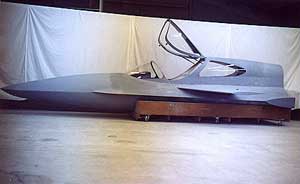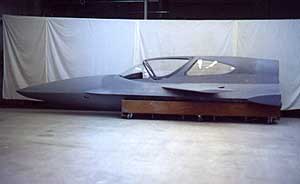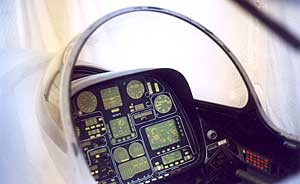Hamilton AeroSpace
VIRTUAL REALITY COCKPIT






|
"Admit it! Joy sticks and a keyboard have never been enough. Your fantasies include a yoke, rudder pedals, a G-suit, and lots of cool knobs and buttons. You want to strap into an ejection seat (not a desk chair), tap the horizon (just to see that it's not stuck), and bank into cloud-studded turns (rather than the wall calendar), etc." So states Matthew Stibbe in the July 2003 issue of AIR & SPACE. He is right. The software programs are great. The computer games have become part of our culture, and all are played or flown at your desk. You are on the outside looking into the video game from the desk or kitchen table, or at your office work area, still on the outside. Hamilton AeroSpace is about to change all of that. Based on the Hamilton AeroSpace "H1 Badger" air frame, a new concept puts the player in the Virtual Reality Interactive Flight Simulator Game Cockpit, designed to bring the "pilot" into the game. The pilot will climb in, strap down, and become part of the game from the inside. The cockpit will bring a realistic surrounding to the game - not a desk top. The screen will be 10 feet high and 15 feet wide. Two side screens, each 10 feet high by 13 feet long, will be on each side. Think of it as a flight inside of IMAX. You, as pilot in command, can interact with additional cockpits anywhere in America. You can go on missions in a flight of one, or as a whole squadron. Software programs today create real life, real time terrain backgrounds from different parts of the world. Combat targets such as air-to-air, air-to-ground, and close air support will realistically reproduce combat scenarios. Not only does the pilot get to engage targets, the pilot is also engaged from the ground and air. Ground positions may track and target and engage the aircraft. Combat flying is a very aggressive problem-solving environment. One of the major goals of Hamilton is to bring realism to the video game. Going from the desk top to a cockpit based on an aircraft design, takes the game to the next level. A level that will further enhance education and entertainment. Another goal of this concept is to expose, at a young age, the youth of America to flight. Flight is one of man's greatest quests. By putting 5th, 6th, 7th or 8th graders in a Virtual Reality Interactive Cockpit, combined with great software, you could open that person's mind to a great adventure. The adventure of flight and aviation! Did you ever dream of being a fighter pilot? I did. Recruit the mind, and the heart will follow. The consoles of today bring hi-tech games to the player. These hand-held consoles only bring a certain degree of realism and entertainment to the player. The Ultimate console is one in which the player can become part of -- an as-if-you-are-there feeling. This feeling cannot be captured by a hand-held console. The "Badger" console is virtual reality and interactive. The interactive "Badger" will enable a player to go on missions with his wingman, his squadron, or multiple squadrons -- attacking targets, dog fighting, and being attacked. Mission profiles from all parts of the world bring Combat Flying Games with virtual reality and interacting with settings into the next generation. The "Badger" consoles will result in the experience of ultimate entertainment. The Virtual Reality Cockpit's primary function is to Entertain, Educate and Rehabilitate. Each year more people are abandoning television and moving towards video games as a form of entertainment. The 18 to 34 year old is the most targeted buyer in the world. Billions of dollars are targeted toward advertising for this age group. The video game industry is gearing up to absorb this new-found form of advertising dollars into the video game culture. Where as a commercial can be turned off on TV, the video game will "product place" or incorporate the product into the culture of the game. The concept is new and growing -- the results have been very positive. Product marketing on video games is a billion dollar business worldwide. The "Badger" Virtual Reality Interactive Air Combat Console will enable a product to be placed in front of a consumer in the midst of an "interactive air combat mission" without distracting from the game or breaking the entertainment format. Hamilton AeroSpace is now in the preliminary phase of establishing The National Association of Cockpit Gamers (NACG) and the International Association of Cockpit Gamers (IACG). The purpose of the Association is to establish competitive leagues Nationally and Internationally. These two associations will be the foundation for a new breed of video gamers - "Cyber Pilots". The National Association of "Cyber Pilots", as well as the International Association of "Cyber Pilots" will be the beginning of a new and advanced concept of video gaming. These "Cyber Pilots" will be able to compete nationally in the U.S. and internationally at the World Championship competition. "Cyber Pilots" from all points of the world will gather for National and International competition will establish points that will lead to the final "Fly Off" by the best "Cyber Pilots" in the world. The formation of these leagues will be open to Individuals, Institutions, Corporations, Public Schools, Universities, Casinos, Motion Picture Theatres, as well as Military Forces. See you on the flight line. |
HAMILTON AEROSPACE
George D. Hamilton
C.E.O.
1194 Wharton's Dock Road
1-830-796-3209
E-mail: george@hamiltonaerospace.com